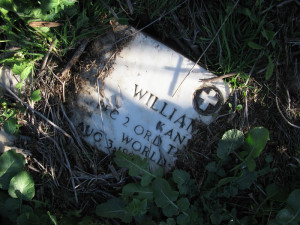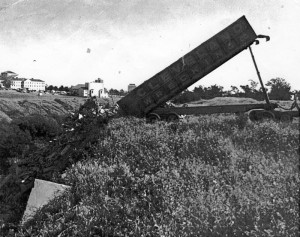Historic dumping grounds beneath the spectacular VA land finally get tested.
By Michael Collins
Several days ago, men wearing radiation dosimeters stood on the Veteran Administration’s West Los Angeles property, atop an old toxic dump that partially underlies Barrington Recreation Center’s baseball fields and a city dog park, and began the federal government’s long-delayed $1 million test of the soils.
The men would not identify themselves but one volunteered that they planned to “core” tubes of dirt to test for contamination along the length of a fenced-off drainage system east of the park.
Yet they were drilling in an area covered with 5,000 truckloads of inert fill dirt, according to a VA report. And they were coring far from key areas that the VA’s own maps show overlay the disused VA and UCLA medical and chemical dumps, long hidden beneath the VA’s chunk of valuable Westside real estate.
According to VA maps, two historic dumping areas lie partially under the city’s Barrington Recreation Center, a popular spot that draws affluent Brentwood residents, including celebrities. Governor Arnold Schwarzenegger has played ball with his boys there.
Yet after years of promises to complete tests and determine what is really buried there, indications show that the property has not been well monitored. A disturbing collection of abandoned soldiers’ tombstones, partially covered by the eroding dirt and debris, have sat for months within the boundaries of the dump study area, in violation of federal regulations requiring dignified, full destruction of such discarded gravestones.
Some of the white marble slabs are whole, others broken. “Rodriguez” died in 1971 after serving in World War II in the Army. His headstone, busted in half and with his first name missing, is one of at least 10 apparently long-ago discarded markers spotted peeking from the dirt since this reporter first noticed them on January 9, 2008.
That day, California Sen. Dianne Feinstein spoke at the VA, where she was honored for legislation preventing commercial development of the Brentwood-adjacent property, one of the choicest pieces of open land in urban Los Angeles. When a reporter told Feinstein about the broken tombstones partially buried in dirt, she responded, “Really?” then turned to her district director, Trevor Daley, and said, “Yes, go out and look at it, will you?” The existence of the grave markers implies that the VA’s chief of external affairs, Ralph Tillman, has not completed an assessment of soils in the study area — to the point of failing to undertake the basic task of properly destroying the gravestones.
Tillman has failed to respond to requests for an interview, but with the federal government finally embarking on a long-delayed $1-million testing phase, Dr. Bennett Ramberg, a longtime critic of the government’s handling of the historic dump, says, “We’re in the more definitive phase and yet, once again, the questionable zones at the site appear to be ignored by the testers. If you’re going to spend $1 million in these tight times, you have got to get it right.”
Tillman has previously insisted that the soils are safe. U.S. Rep. Henry Waxman of Los Angeles says, “I am pleased that they are taking this additional step, and I will be monitoring the situation closely.”
A controversial $4 billion Bush Administration plan to develop the property, opposed by many Angelenos because the land is located in one of Southern California’s most congested and overbuilt areas, collapsed in 2007 in part because of its surprisingly troubled history.
On September 22, 2007, Jay Halpern, special assistant to the VA secretary, told concerned residents at a community meeting that one obstacle to developing luxury condos and businesses on the massive property was “the issue around the radiation of Barrington Park.”
Halpern said questions about whether radiation problems exist on the site were addressed in a Phase One report, but added, “Now we enter the Phase Two study to ensure that there is absolutely nothing underneath there.”
But Ramberg, one of several critics of the two-year delay before the Phase Two study began late this year, says, “How is the public supposed to rely on the conclusions of the Phase Two study when the VA appears to have prejudged the outcome?”
Although the testing site, which is fenced with “Do Not Enter” signs, is not easily visible downslope from the Brentwood Recreation Center, it is in full view of the adjacent MacArthur Field to the east. The land was used to dump biomedical nuclear and chemical waste from 1948 to 1968 by the VA and nearby UCLA.
According to UCLA archival documents, the buried items include barrels of radioactive tritium, chemical lab wastes, and carcasses of animals killed in medical experiments.
Nobody knows if the land is safe. Last February, an unidentified man inspecting the site with a member of the Nuclear Regulatory Commission stated, “This is just perfect for the media. You build a dog park over a nuclear dump. People care more about dogs than people, but people are walking on it!”
VA and UCLA documents also show that hazardous chemicals, including toluene and dioxane, are buried under the soil. According to VA records of 1960 to 1968, wastes were tossed or poured into the site by deposit into unlined trenches and holes. For the first 12 haphazard years, no records were kept.
But in a 2006 interview, Ben K. Spivey, then chief of occupational health and safety at the VA, said that a mound of plant-covered debris, roughly near the center of the historic dump, marks an area where biomedical waste was deposited — after being excavated from land now beneath the exclusive, adjacent Brentwood School.
Some residents and parents were worried after Phase One results by a testing contractor found potential problems near and on Brentwood School land and the arroyos, or washes, that run along the western edge of the VA’s land.
“The average readings for the East Arroyo, West Arroyo and the Brentwood School lower soccer fields were notably above” control areas with natural levels of radiation, according to the contractor, Pleasant Hill–based Millennium Consulting.
Millennium recommended further investigation, citing “strong concern by members of the community,” historical documentation of dumping, and radiation detected by the contractor.
Buried radioactive materials may not be the only problem. After analyzing thousands of pages in dozens of VA reports that Waxman posted on his Web site, the Weekly has learned that Brentwood School’s fields may contain heavy metals. According to heavy-metal readings from a November 21, 2000, Locus Technologies report called “Brentwood School Athletic Fields Grading Project and Recreation Facility Project,” arsenic was found at 32 times the natural level while thallium was at an amount that the government terms “chronic” for causing disease. Brentwood School head Michael D. Pratt says that in 2006 Environ conducted a $150,000 study in response to findings reported on EnviroReporter.com. According to Pratt, testing for “radionuclides, hydrocarbons, VOCs and various heavy metals, including arsenic and thallium,” failed to detect any thallium and arsenic “in concentrations above normal background levels.”
However, according to documents and maps obtained by the Weekly, only four of the 12 soil borings taken by Environ were in areas known to contain toxic waste or incinerator ash from cremated lab animals at UCLA and the VA.
In one January 2000 document, the firm URS Greiner Woodward Clyde reported to the VA that Brentwood School’s athletic fields were built in an area used as a dump by three hospitals until the early 1970s.
Brentwood School has insisted that the property where the football and baseball fields are located is free of waste. However, according to the Locus report, old medical syringes floated up to the surface in October 2000 during construction of a drain for the school’s football field.
“The syringes were often in plastic bags,” reported URS. After that, the so-called lower bench, where the Brentwood Eagles play football, was covered by a thick layer of asphalt that today is hidden beneath the turf.
—Contact the writer at EnviroReporter.com, where reporters Michael Collins and Denise Duffield exposed the existence of the historic dump in May 2006.













Recent Comments